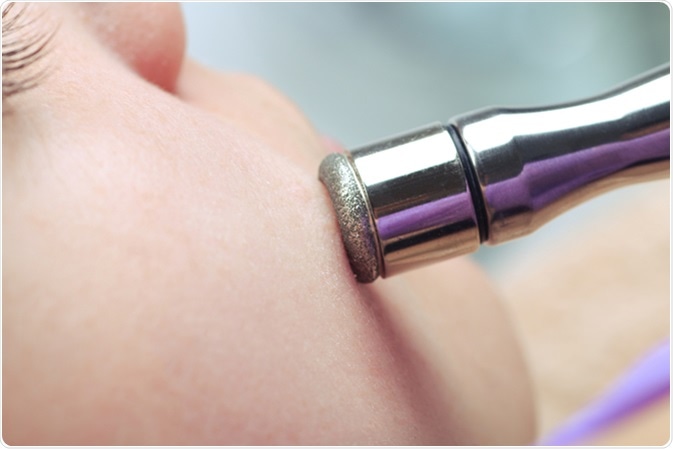Dermabrasion is a form of surgical treatment of skin scars and wrinkles, among other superficial skin conditions. It consists of scraping away the topmost layers of the skin to produce a smoother surface. It is usually performed under local anesthesia and the recovery may take up to 10 days roughly.
The healing skin underneath the ointment or dressing will appear pinkish throughout the first few weeks and must be kept clean and moist to assure optimal healing. The main focus of this procedure has been treating acne and surgical scars, wrinkles, and cosmetic facial skin smoothening.
The most commonly used tools are the portable handheld dermabrader units rotating at up to 35, 000 rpm with attached diamond fraises, fine wire brushes or serrated wheels. Surgical expertise and precision is indispensable to achieve the desired results.

Diamond microdermabrasion, peeling cosmetic. Image Credit: tcsaba / Shutterstocki
Dermabrasion vs. Electroabrasion
Dermabrasion has been compared to electroabrasion with respect to the efficacy and risks of these procedures for scar improvement. There is no statistically significant difference between them in these aspects, however, the latter takes much less time and causes much less hemorrhage. Electroabrasion would appear to be a preferable alternative in many cases.
Dermasanding
Another variation of dermabrasion for reducing the depth of surgical scars has been founded on the use of sterile sandpaper compared to motorized diamond fraise dermabrasion. Sandpaper is safe and simple to obtain, additionally being much less expensive. Both methods proved equally effective in 80% of patients according to one study, with well over half of them having marked improvement. Various parameters such as contour realignment, visibility of the scar, time taken for new epithelial growth, and pigmentation changes, were all taken into consideration while assessing the results. The remaining 20% of patients failed to show any positive outcome following either procedure.
Diamond Fraise vs. Wire Brush Dermabrasion
Studies comparing these two conventional modalities when used to treat photoaged skin have shown a good result with respect to removal of actinic keratosis lesions, wrinkles and lentigines, both clinically and histologically. Thus either method could be selected to improve collagen synthesis in treating photodamage to the skin.
Dermabrasion vs. Fractionated Carbon Dioxide Laser
When used as a single treatment for the revision of surgical scars, fractionated CO2 laser results in less redness and bleeding as well as less edema at 1 week, 1 month, and 3 months as compared to dermabrasion. It is thus safer and is associated with a shorter recovery time, while being equally effective with respect to cosmetic improvement. Laser resurfacing has thus replaced dermabrasion in many cosmetic applications.
Clinical Improvement with Newer Dressings vs. Conventional Dressing
Dressing the dermabrasion wound with conventional dressing has been compared to the use of Omiderm, which is a hydrophilic copolymer membrane. Another option is the use of a biosynthetic occlusive dressing which requires little care and shortens recovery times significantly by up to 50%.
Newer Applications of Dermabrasion
Dermabrasion for acne scars has been a widely popular procedure, but recent interest has awakened in the utility of this procedure to complement various facial plastic surgery procedures in the head and neck.
Dermabrasion has not shown to have any efficacy in reducing the risk of skin cancer (non-melanoma type) with current data in human studies, probably because the malignant change begins deep in the hair follicles which are not touched during this procedure.
References
- https://www.ncbi.nlm.nih.gov/pubmed/24641302
- https://www.ncbi.nlm.nih.gov/pubmed/12789182
- https://www.ncbi.nlm.nih.gov/pubmed/12164741
- https://www.ncbi.nlm.nih.gov/pubmed/12164741
- https://www.ncbi.nlm.nih.gov/pubmed/8642088
- https://www.ncbi.nlm.nih.gov/pubmed/12814336
- https://www.ncbi.nlm.nih.gov/pubmed/22268699
- https://www.ncbi.nlm.nih.gov/pubmed/1828255
- https://www.ncbi.nlm.nih.gov/pubmed/3584632
- https://www.ncbi.nlm.nih.gov/pubmed/7807639
- https://www.ncbi.nlm.nih.gov/pubmed/11083571
- https://link.springer.com/chapter/10.1007/978-3-540-79341-0_25
Further Reading